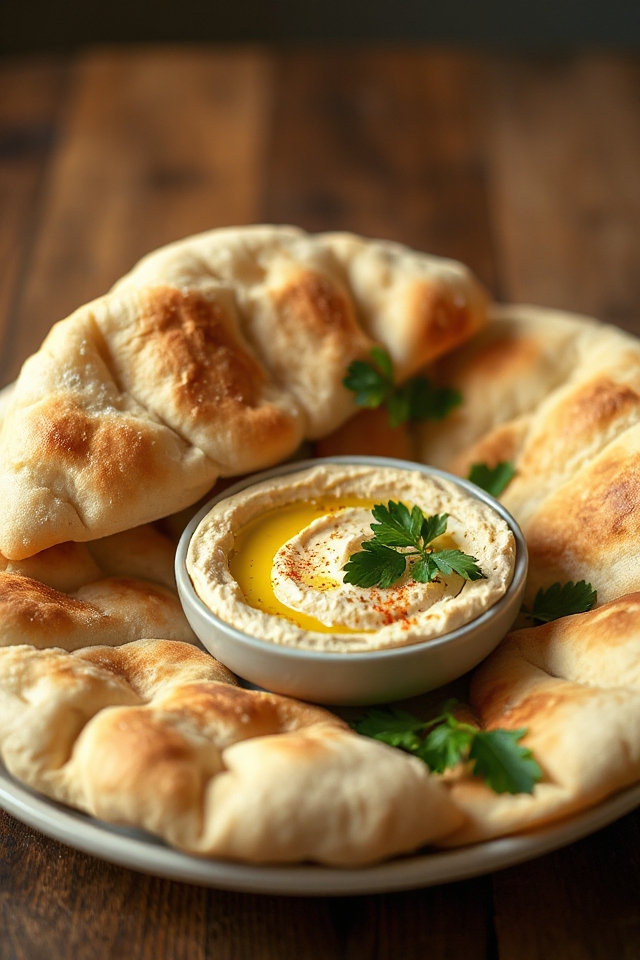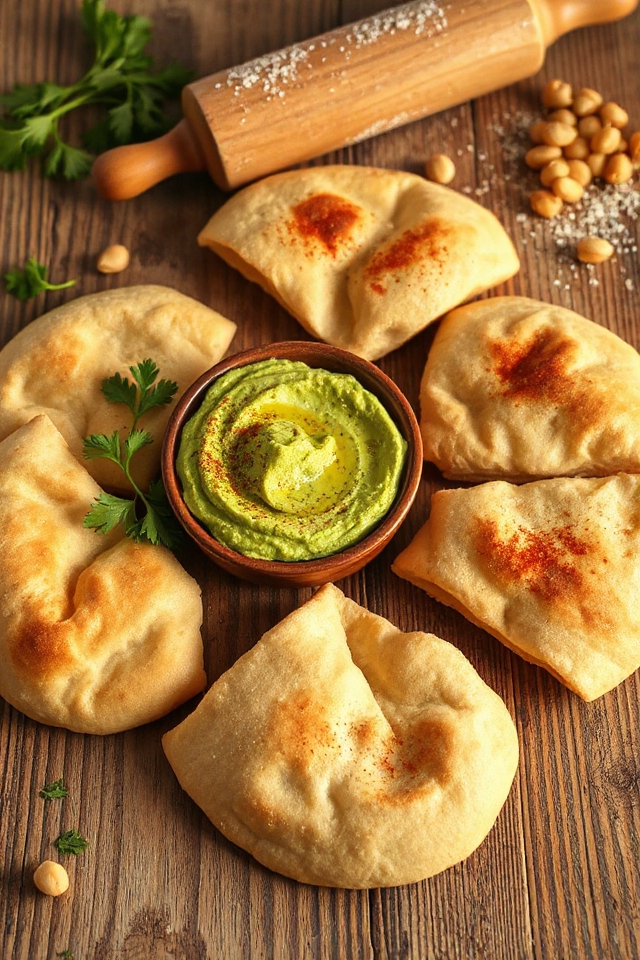Why You’ll Love This Gluten Free Pita Bread Recipe
You’ll love this gluten-free pita bread recipe for its incredible texture and flavor. I can’t get enough of how soft and chewy these pitas turn out, making them perfect for stuffing with your favorite fillings.
The slight crunch on the outside gives way to a warm, pillowy interior that’s just irresistible. Plus, the aroma that fills your kitchen while they bake is simply heavenly!
Whether you’re enjoying them fresh or freezing for later, they make every meal feel special. I promise you’ll savor every bite, and your gluten-free friends will be asking for the recipe, too!
Give it a try!
Ingredients of Gluten Free Pita Bread
Making gluten-free pita bread is a delightful adventure that’s worth every moment in the kitchen. With a few simple ingredients, you can create puffy pockets of bread that aren’t only delicious but also super fun to make.
Whether you’re planning to stuff them with savory fillings or just dip them in hummus, these pitas are sure to impress. So, let’s gather our ingredients and get started on this culinary journey!
Ingredients for Gluten Free Pita Bread:
- 1 1/3 cups cornstarch
- 1 cup tapioca starch or tapioca flour
- 2/3 cup garbanzo flour or garfava flour
- 1/3 cup sorghum flour
- 2 tablespoons sugar
- 1 tablespoon xanthan gum
- 2 1/4 teaspoons quick-rising yeast
- 1/2 teaspoon salt
- 1 1/4 cups warm water
Now, before you plunge into mixing these ingredients together, let’s chat a bit about them. Each flour brings its own special characteristics to the table, or in this case, the dough.
Cornstarch and tapioca give that soft, chewy texture we all love, while garbanzo flour adds a nutty flavor that makes each bite more interesting.
And let’s not forget the xanthan gum—it’s the secret superhero that helps bind everything together, preventing our pita from turning into a crumbly disaster (we’ve all had those kitchen mishaps, right?).
If you’re like me and find yourself standing in the grocery aisle, puzzled over which flour to grab, don’t stress. Just remember that this combination is what’ll give you those light and fluffy pitas you’re dreaming of.
Happy cooking!
How to Make Gluten Free Pita Bread

Making gluten-free pita bread is a bit like starting a fun science experiment in your kitchen. First up, you’ll want to grab your mixing bowl and combine all those dry ingredients: 1 1/3 cups cornstarch, 1 cup tapioca starch (or flour if that’s what you have), 2/3 cup garbanzo flour, 1/3 cup sorghum flour, 2 tablespoons sugar, 1 tablespoon xanthan gum, and 1/2 teaspoon salt.
Give them a good whisk to mingle, and then set that bowl aside. Now, pour 1 1/4 cups of warm water into your bread maker pan, and it’s time to add that dry mixture. Set your bread maker to the dough setting and let it work its magic. You might need to scrape the sides with a spatula—don’t worry, sticky dough is part of the experience. Knead it for about 5 minutes, and then voilà, your dough is ready!
Now for the fun part! Remove that soft, sticky dough from the pan and divide it into six to eight balls. Cover them up and let them hang out for a bit. While they’re resting, you can flour your rolling surface with cornstarch—trust me, a generous dusting is key here.
Grab one dough ball, and with light hands, roll it into a circle about 6 inches wide and a quarter-inch thick. If it sticks, just add more cornstarch. The goal is to keep it chewy and crusty, not tough—no one wants a workout chewing their pita.
Place each rolled pita onto a greased cookie sheet sprinkled with cornmeal or gluten-free flour, cover them with waxed paper, and let them rise in a warm spot for about 30-40 minutes.
Once those pitas have puffed up nicely, preheat your oven to a hot 450° F. Time to bake! Remove the waxed paper, flip those pitas over, and let them bake for 3-5 minutes. When they start to look lightly browned and set, flip them again and pop them back in for another 3-5 minutes.
Once they’re done, wrap them in a dishtowel for a few minutes to keep them nice and warm. Finally, grab a sharp knife and split them along the pocket edge. Stuff them to your heart’s content or enjoy them with some hummus, but whatever you do, make sure to savor that first bite of your homemade gluten-free goodness.
And if they don’t turn out perfect? Well, at least you have a great story to tell about your culinary adventure. Happy baking!
Gluten Free Pita Bread Substitutions & Variations
While experimenting with gluten-free pita bread, I’ve discovered that there are plenty of substitutions and variations that can enhance both flavor and texture.
For instance, if you’re looking for a nutty taste, try replacing some cornstarch with almond flour. You can also swap out garbanzo flour for quinoa flour for a protein boost.
If you want a savory twist, adding herbs like oregano or thyme can elevate the flavor. For a touch of sweetness, consider using honey instead of sugar.
These tweaks not only make the pita unique but also allow you to cater to your personal preferences and dietary needs.
Additional Tips & Notes
Experimenting with different ingredients can lead to exciting results when it comes to gluten-free pita bread. I’ve found that adding herbs like oregano or rosemary can elevate the flavor.
Don’t hesitate to adjust the hydration level; if your dough feels too dry, a splash more water can help. When rolling out the dough, keep it well-floured to prevent sticking.
If you want softer pitas, reduce the baking time slightly. Ultimately, wrapping the pitas right after baking keeps them warm and prevents them from drying out.
Enjoy the process, and remember, practice makes perfect!
